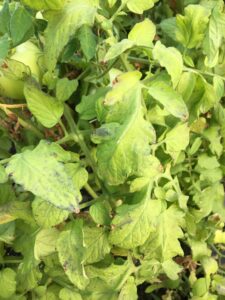After the heavy rains in the past a few days, flooding/waterlogging injury stands out in my farm visit this week.
Regardless of tomato or cucumber, the injured plants showed leaf yellowing that occurred 2 to 3 days after waterlogging (Figure 1). The yellowing leaves are a result of chlorophyll loss, which is associated with N deficiency and abnormal N metabolism. In addition to yellowing leaves, plant responses to flooding injury can be premature leaf senescence, reduced plant growth, formation of adventitious roots, and increased susceptibility to disease and insect pests.
There is not much we can do in the middle of the season to avoid waterlogging happening on the vegetables. But here are some remedy approaches that may be taken to alleviate the deleterious effects and help the crops to recover.
Use nitrogen (N) fertilizers. There are many discussions on whether foliar fertilizers are beneficial. This is one of the cases that foliar fertilizers may do better than soil fertilizers. A study conducted in southern Florida on corn showed that foliar spraying of urea, calcium nitrate and potassium nitrate were more effective in recovering leaf greenness than soil N fertilizers. The study concluded N was more readily absorbed by the plants through leaves than by the damaged roots after waterlogging. Although no significant differences in plant recovery were found comparing foliar sprays of urea, calcium nitrate, and potassium nitrate in this study, nitrate N fertilizers, especially potassium nitrate fertilizers are recommended. Ammonium nitrogen fertilizers are not the best option because the microorganisms that convert ammoniacal nitrogen to nitrate nitrogen compete for oxygen with plant roots in low-oxygen conditions, which could potentially exacerbate waterlogging damage.
Using oxygen-containing fertilizer might be a potential strategy to minimize the waterlogging damage. In a greenhouse experiment with basil, applying oxygen-containing fertilizers [carbamide peroxide (urea, hydrogen peroxide), calcium hydroxide] before waterlogging enhanced N use efficiency and improved crop recovery after waterlogging. The mechanism is not fully understood, but enhanced oxygen bioavailability and improved soil redox potential in vegetable root zones are considered factors that contribute to the positive effects.
Greenhouse studies also showed plant growth regulators such as synthetic gibberellic acid and synthetic cytokinin had positive effects to alleviate waterlogging damage. However, there was little evidence approving their effects in field conditions. It is important to note that some regulators may potentially inhibit crop recovery if inappropriately used, which affecting photosynthesis and leaf transpiration.
Reference
Rao, R. et al., 2002. Assessment of foliar sprays to alleviate flooding injury in corn (Zea Mays L.). Proc. Fla. State Hort. Soc. 115:208-211
Liu, G. et al., 2013. Application of oxygen fertilizers in rescuing aged vegetable seeds and alleviating flooding stress in horticulture. International Journal of Vegetable Science. 19:217-227.
Liu G., Y, Li and X. Fu. 2019. Practices to minimize flooding damage to commercial vegetable production. IFAS University of Florida. DOI: doi.org/10.32473/edis-ss425-2003
